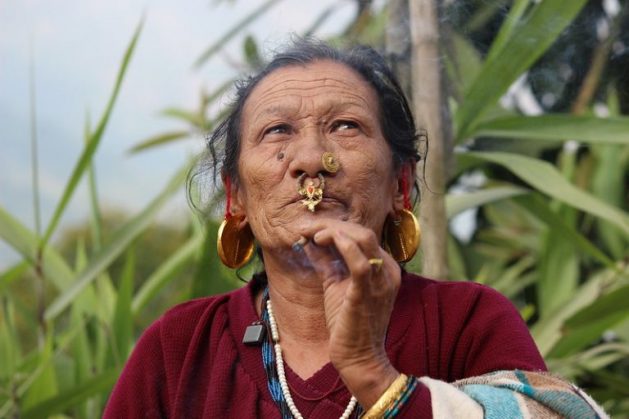Biodiversity: Indigenous Peoples, the Last Custodians

MADRID, Apr 29 (IPS) - Every now and then, experts remind that the Indigenous Peoples are the best (and last?) custodians of the essential web of life: biodiversity.
There are more than 370 million self-identified peoples in some 70 countries around the world. In Latin America alone there are over 400 groups, each with a distinct language and culture, though the biggest concentration is in Asia and the Pacific– with an estimated 70 per cent.
And their traditional lands guard over 80% of the planet’s biodiversity.
Indigenous Peoples have rich and ancient cultures and view their social, economic, environmental and spiritual systems as interdependent. And they make valuable contributions to the world’s heritage thanks to their traditional knowledge and their understanding of ecosystem management
They know how to connect with Nature
No wonder they play such an essential role: over the millennia, indigenous peoples around the world have developed practices that safeguard their environments and honour the interconnectedness of people and nature.
Their food systems are rooted in their environment. Living deeply intertwined with their ecosystems, imdigenous peoples have learned how to harvest and produce what they need sustainably, reminds, once more, the International Fund for Agricultural Development (IFAD).
The Fund, which delivers grants and loans to the poor farmers and rural population worldwide, with nearly zero interest and the facility of repayment in long periods of time, also provides the following information.
For example, we’ve seen time and again that, when forests are governed by indigenous peoples, there’s less deforestation and biodiversity loss. It’s no wonder that their role as responsible environmental stewards has been documented on every inhabited continent.
Yet, they are more and more vulnerable
Yet indigenous peoples disproportionately struggle with poverty. In the 23 countries where most of the world’s indigenous peoples live, they make up 9.3% of the population, but over 18% of those in extreme poverty.
Meanwhile, IFAD explained on 22 April 2022, that their contributions are frequently ‘overlooked and devalued.’ All too often, indigenous peoples’ communities aren’t able to participate in economic and food systems without giving up their traditions and knowledge.
“They’re left out of decision-making about the lands and resources they know better than anyone. They don’t have the agency, financial resources or capacity to take charge.”
Does anybody care?
And today, with climate change affecting every part of the globe, their knowledge and practices are more important than ever.
The Fund works with indigenous peoples to support them in overcoming poverty and showing the way to meeting global challenges through building on their identities and cultures.
But even when there is a plan: Policy on Engagement with Indigenous Peoples, and the International Fund for Agricultural Development converts its commitment into action through the Indigenous Peoples’ Forum, the key role of indigenous people in safeguarding biodiversity is too often neglected, if ever taken seriously into account.
In fact, for the last 15 years, the Indigenous Peoples Assistance Facility (IPAF) has served as IFAD’s flagship funding instrument for indigenous peoples, putting the power to find and implement solutions directly into their hands.
The IPAF aims at empowering indigenous peoples’ organisations. It helps them access climate finance so they can direct funds where they see the greatest need, and promotes the implementation of indigenous peoples’ rights frameworks, in line with the United Nations Declaration on the Rights of Indigenous Peoples.
Indigenous Peoples fight for the Planet
For its part, the World Wildlife Fund (WWF) has reiterated that by fighting for their lands, Indigenous peoples are fighting to save the planet.
Although they comprise less than 5% of the world population, Indigenous peoples protect 80% of the Earth’s biodiversity in the forests, deserts, grasslands, and marine environments in which they have lived for centuries, WWF goes on.
“However, despite their critical role in ensuring a resilient and healthy planet for people and nature, there is very little acknowledgment of, or support for, their efforts, especially in Africa.”
Our planet is facing a deep crisis rooted in a number of interconnected, global challenges that include infectious diseases like COVID-19, but also climate change, biodiversity loss, and financial collapse, according to WWF, one of the world’s leading conservation organisations, working in nearly 100 countries.
“These challenges do not observe national or physical borders and primarily result from human activities such as deforestation, the burning of fossil fuels, the expansion of agricultural land, and the increased hunting and trading of wildlife.”
 Brazilian Indigenous people during one of their regular protests in Rio de Janeiro demanding the demarcation of their lands and to be taken into account in environmental and climate measures. Credit: Mario Osava / IPS
Brazilian Indigenous people during one of their regular protests in Rio de Janeiro demanding the demarcation of their lands and to be taken into account in environmental and climate measures. Credit: Mario Osava / IPS
Continuous non-recognition, abuse
Most of these activities are undertaken, habitually, in Indigenous peoples’ territories without their free, prior, and informed consent, it explains.
“The continued non-recognition and abuse of Indigenous peoples’ land rights, and consequently the dismissal of 80% of global biodiversity, should be placed at the centre of present and future global challenges.”
Now, scientists, specialists and experts from all over the world are working to prepare for the UN Biodiversity Conference (COP 15), which is scheduled to take place later this year in Kunming, China.
Indedigenous Peoples will surely be present and their voice will be heard, but will it be ‘listened to’?
© Inter Press Service (2022) — All Rights Reserved. Original source: Inter Press Service
 Global Issues
Global Issues